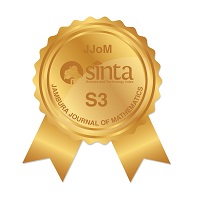Application of Recursive Algorithm on Shamir's Scheme Reconstruction for Cheating Detection and Identification
Abstract
Keywords
Full Text:
PDFReferences
Z. N. Ahzan, S. Guritman, and B. P. Silalahi, "Deteksi dan Identifikasi Pelaku Kecurangan Skema Pembagian Rahasia Linear Berbasis Skema Shamir" Jurnal Karya Pendidikan Matematika, vol. 7, no. 1, pp. 27-41, 2020.
A. Shamir, "How to share a secret" Communications of the ACM, vol. 22, no. 11, pp. 612-613, nov 1979, doi: http://dx.doi.org/10.1145/359168.359176.
G. R. Blakley, "Safeguarding cryptographic keys" in 1979 International Workshop on Managing Requirements Knowledge (MARK). IEEE, jun 1979, pp. 313-318, doi: http://dx.doi.org/10.1109/MARK.1979.8817296.
M. Tompa and H. Woll, "How to share a secret with cheaters" Journal of Cryptology, vol. 1, no. 3, pp. 133-138, oct 1989, doi: http://dx.doi.org/10.1007/BF02252871.
T. Rabin and M. Ben-Or, "Verifiable secret sharing and multiparty protocols with honest majority" in Proceedings of the twenty-first annual ACM symposium on Theory of computing - STOC '89. New York, New York, USA: ACM Press, 1989, pp. 73-85, doi: http://dx.doi.org/10.1145/73007.73014.
A. Slinko, "Ways to merge two secret sharing schemes" IET Information Security, vol. 14, no. 1, pp. 146-150, jan 2020, doi: http://dx.doi.org/10.1049/iet-ifs.2019.0210.
D. Becerra and G. Vega, "Secret Sharing Scheme with Efficient Cheating Detection" in Proceedings of the 2nd International Conference on Networking, Information Systems and Security - NISS19. New York,: ACM Press, 2019, pp. 1-7, doi: http://dx.doi.org/10.1145/3320326. 3320331.
Y. Liu, "Linear ( k , n ) secret sharing scheme with cheating detection" Security and Communication Networks, vol. 9, no. 13, pp. 2115-2121, sep 2016, doi: http://dx.doi.org/10.1002/sec.1467.
Y. Liu, C. Yang, Y. Wang, L. Zhu, and W. Ji, "Cheating identifiable secret sharing scheme using symmetric bivariate polynomial" Information Sciences, vol. 453, pp. 21-29, jul 2018, doi: http://dx.doi.org/10.1016/j.ins.2018.04.043.
K. H. Rosen, Discrete Mathematics and Its Application, 8th ed. New York: McGraw-Hill Education, 2019.
L. Harn, C.-F. Hsu, Z. Xia, and J. Zhou, "How to Share Secret Efficiently over Networks" Security and Communication Networks, vol. 2017, pp. 1-6, 2017, doi: http://dx.doi.org/10.1155/2017/5437403.
A. Patra and D. Ravi, "Beyond Honest Majority: The Round Complexity of Fair and Robust Multi-party Computation" in Advances in Cryptology - ASIACRYPT, 2019, pp. 456-487, doi: http://dx.doi.org/10.1007/978-3-030-34578-5 17.
L. Harn, Z. Xia, C. Hsu, and Y. Liu, "Secret sharing with secure secret reconstruction" Information Sciences, vol. 519, pp. 1-8, may 2020, doi: http://dx.doi.org/10.1016/j.ins.2020. 01.038.
M. Xiao and Z. Xia, "Security Analysis of a Multi-secret Sharing Scheme with Unconditional Security" in SpaCCS 2020, LNCS, 2021, ch. 12383, pp. 533-544, doi: http://dx.doi.org/10.1007/978-3-030-68884-4 44.
S. Cabello, C. Padro´ , and G. Sa´ez, "Secret sharing schemes with detection of cheaters for general access structure" Des. Codes Cryptogr., vol. 25, no. 2, pp. 175-188, 2002.
S. Mashhadi, "Secure publicly verifiable and proactive secret sharing schemes with general access structure" Information Sciences, vol. 378, pp. 99-108, feb 2017, doi: http://dx.doi.org/10.1016/j.ins.2016.10.040.
S. Banerjee, D. S. Gupta, and G. P. Biswas, "Hierarchy-based cheating detection and cheater identification in secret sharing schemes" in 2018 4th International Conference on Recent Advances in Information Technology (RAIT). IEEE, mar 2018, pp. 1-6, doi: http://dx.doi.org/10.1109/RAIT.2018.8389094.
DOI: https://doi.org/10.34312/jjom.v4i1.12001
Copyright (c) 2022 Rafika Husnia Munfa'ati, Sugi Guritman, Bib Paruhum Silalahi

This work is licensed under a Creative Commons Attribution-NonCommercial 4.0 International License.
Jambura Journal of Mathematics has been indexed by
Jambura Journal of Mathematics (e-ISSN: 2656-1344) by Department of Mathematics Universitas Negeri Gorontalo is licensed under a Creative Commons Attribution-NonCommercial 4.0 International License. Powered by Public Knowledge Project OJS.
Editorial Office
Department of Mathematics, Faculty of Mathematics and Natural Science, Universitas Negeri Gorontalo
Jl. Prof. Dr. Ing. B. J. Habibie, Moutong, Tilongkabila, Kabupaten Bone Bolango, Gorontalo, Indonesia
Email: [email protected].




















